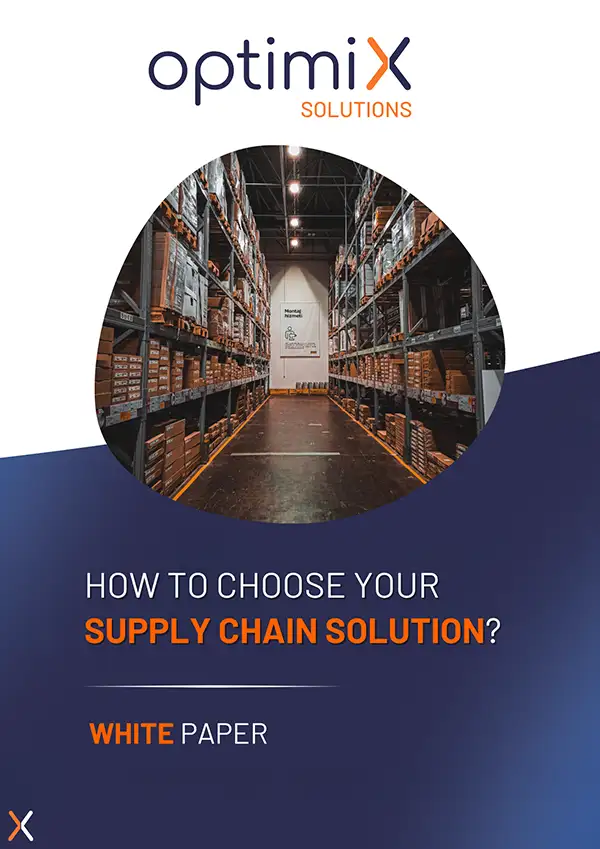Inventory management is at the heart of logistics performance for companies in all sectors. Much more than simply tracking incoming and outgoing goods, it determines the ability to meet demand, optimize costs, avoid stock-outs and overstocking, and ensure customer satisfaction.
In an increasingly unstable and demanding market context, marked by multiple distribution channels, volatile demand and pressure on lead times, efficient stock management is becoming a decisive competitive advantage.
This article provides a comprehensive overview of the fundamental principles, management methods, strategic issues and technological tools that enable agile, precise and sustainable inventory management today. Whether you’re a small or medium-sized business, a manufacturer or a retailer, controlling your inventory is essential to your logistical success.
What is stock management?
Inventory management refers to all the practices and processes used to monitor, organize and optimize the flow of goods in a company. It begins at the point of procurement and continues right through to stock removal, whether for sale, transfer or internal consumption.
This central function of the supply chain is designed to answer a key question: how do you get the right products, in the right quantities, at the right time and in the right place, while minimizing costs ? Efficient inventory management secures business activity, limits losses, and guarantees product availability for end customers. It also relies on the use of good inventory management software for greater efficiency.
Why is inventory management important?
Inventory management plays a strategic role in a company’s overall performance. It affects both quality of customer service, financial profitability and supply chain robustness.
Poor anticipation can lead to stock-outs, resulting in lost sales and brand image damage. Conversely, heavy overstocking ties up cash, takes up storage space unnecessarily, and increases the risk of obsolescence or expiry.
The main characteristics of good inventory management
Successful inventory management depends on data reliability, responsiveness to fluctuations and the ability to anticipate needs. It implies traceability of all item movements, from receipt to dispatch, as well as rigorous recording of operations.
A segmentation This allows us to apply more precise, differentiated strategies. Last but not least, good inventory management is based on performance indicators (KPIs) that enable corrective actions to be managed in real time.
How does stock management work? The different stages
There are several stages in stock management. It begins with procurementwhich includes supplier selection, the negotiation conditions and planning orders. Goods receipt is accompanied by quality control and immediate updating of databases.
Next, products are stored according to optimal organizational logic (FIFO, coded locations, specific conditions). Throughout their lifecycle, items undergo movements (in, out, transfers) which must be accurately recorded. Finally, supervision of the whole system relies on reporting, alert and analysis tools.
What are the different technologies available for inventory management?
Modern technologies are profoundly transforming inventory management. ERP systems ensure global coordination between purchasing, production, logistics and finance functions. WMS systems enable detailed management of warehouses, locations, picking tasks and physical flows.
SaaS solutions offer an agile and scalable approach, combining artificial intelligence, demand modelingscenario simulation and automated replenishment. Finally, connected objects (IoT sensors, RFID tags) and mobile terminals enable fast, reliable data capture in real time.
To find out more on this subject, we invite you to read our article here
Inventory management challenges
Inventory management faces both structural and cyclical challenges. One of the biggest challenges is the need for predictability of demanddemand is subject to many vagaries: consumption trends, weather, health or economic crises.
Other constraints include limited storage capacity, variable lead times, and the growing complexity of multi-channel distribution networks. The diversity of products, their heterogeneous life cycles and specific storage conditions add to the difficulty.
How are inventories managed? Different inventory management methods
There are a number of different inventory management methods, depending on the nature of the products, their rotation and operational constraints.
The ABC method classifies items according to their importance (A for the most strategic, C for the least critical), in order to optimize management efforts.
Just-in-time aims to minimize inventory by triggering supplies as close as possible to actual demand.
The reorder point enables automatic replenishment as soon as a predefined threshold is reached, often coupled with a safety stock to deal with unforeseen events.
Finally, the Kanban method, used mainly in industrial environments, relies on a visual system to trigger replenishments in a fluid, reactive manner.
To discover each method in detail and understand how to apply them effectively, read our complete article dedicated to stock management methods.
How can you better manage your inventory?
To improve inventory management, it’s essential to work on several fronts simultaneously. The first step is to make data reliableby carrying out regular rolling inventories and raising team awareness.
Next, we need to improve forecast accuracyby integrating external data (market trends, weather, seasonality). The implementation of intelligent alerts and customized dashboards enables us to react more quickly to any deviations. Finally, collaboration with suppliers can be optimized through s or consigned stock agreements.
We invite you to discover our article on : how to optimize your stock management?
The best inventory management software
Inventory management is a strategic lever for any high-performance supply chain.
In the face of volatile demand and pressure on lead times, high-performance inventory management software is a must.
These tools provide real-time visibility, make flows more reliable, reduce out-of-stocks and optimize stock levels thanks to predictive analysis. The result: improved service rates, better stock rotation and a direct contribution to profitability.
Our guide presents the best inventory management softwarewith a focus on their key features and concrete benefits for supply chain managers.
Optimix Forecasting and Replenishment - XFR: inventory management made easy
XFR Optimix Forecasting and Replenishment stands out for its ability to manage your Supply Chain, drawing on the power of data and technological agility. Where companies have to juggle product diversity, demand variability, storage constraints or supplier lead times, XFR acts as an intelligent platform that centralizes information, automates critical decisions and aligns flows with business objectives.
Its forecasting engine exploits historical, promotional and external data (weather, seasonality, trends) to adjust stock levels in real time, reduce out-of-stocks and limit overstocks. Thanks to a intuitive visual interfaceXFR provides a consolidated view of key KPIs (turnover, coverage, service rate), enabling logistics managers to spot areas of tension, take immediate action, and simulate several management scenarios to make the most profitable decisions.
Where traditional methods show their limitations, XFR streamlines every step These include calculation of net requirements, automated order generation, inventory management by product type (ABC method, order point, JIT), and integration with supplier flows. Compatible with your in-house tools, the solution is equally suited to SMEs and large organizations seeking flexibility, reliability and sustainable performance. Its SaaS approach facilitates deployment, scalability and cross-team collaboration.
What challenges do retailers face in managing their inventories?
Inventory management is a strategic lever that directly influences profitability, service quality and overall supply chain performance. The challenges of inventory management are multiple: guaranteeing product availability, avoiding stock-outs, limiting overstocking and optimizing financial immobilization.
However, meeting these objectives involves a number of challenges: anticipating often fluctuating demand, coordinating flows between different channels, managing supplier lead times, and maintaining reliable data in real time. Efficient inventory management therefore requires appropriate tools, capable of piloting flows with agility and precision.
An example of inventory management: Buffalo Grill
Buffalo Grill is one of France’s largest restaurant chains, with over 360 restaurants throughout the country. In such an environment, inventory management becomes an essential strategic lever. The chain has to cope with high volumes, constant freshness requirements and multi-site logistics flows, while controllingcosts and reducing losses.
The challenge is to anticipate demand, guarantee product availability and streamline restocking, without compromising service quality. The only way to achieve this balance is through fine-tuned management and a high-performance management tool.
To meet these requirements, Buffalo Grill has chosen to manage its inventory with the software XFR – Optimix Forecasting and Replenishment. This supply chain solution enables highly accurate demand forecasting, based on historical data, seasonality and promotions.
Thanks to XFR :
Restaurants receive precise consumption forecasts for every product, from steak to dessert.
Teams can adjust their supplier orders according to these forecasts, thus avoiding surpluses or shortages.
Data is centralized and shared in real time, enabling efficient management at both head office and local levels.
The software automatically identifies unusual consumption deviations and suggests adjustments.
For example, during the summer months, XFR anticipates a rise in consumption of salads and cold drinks, enabling us to increase order volumes in tourist areas, while limiting stocks in other, less frequented regions.
Result:
Better stock rotation,
Reduced food waste,
And an overall improvement in logistics profitability.
This case study shows how a traditional retailer can gain in efficiency and responsiveness thanks to an automated, predictive inventory management solution.
Inventory management is no longer limited to counting or warehouse logic. It has become a strategic competitive leverageThis is a key factor in the company’s ability to directly influence profitability, sales responsiveness and the customer experience. In a world where uncertainties are manifold, and expectations are increasingly high, companies can no longer simply manage their inventories “the old-fashioned way”.
The integration of high-performance tools such as Optimix solutions’ XFR inventory management solution enables a proactive, predictive and data-driven approach. By automating repetitive tasks, facilitating decision-making and optimizing the balance between costs and service, these solutions transform inventory management into a sustainable competitive advantage. For ambitious companies, this is an essential part of their logistical and commercial success.








